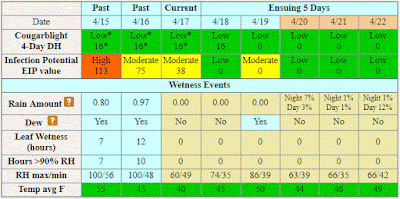NOTE: Many apple varieties in the Winchester area are approaching full bloom and should be near full bloom for this week's Shenandoah Apple Blossom Festival. Below are the fire blight risk assessments, comparing graphics from Maryblyt 7, and also from the Cougarblight model as shown on our NEWA site. We will be using the same weather data from our NEWA station to make these comparisons. We thank Dr. Mizuho Nita for hosting the Maryblyt 7.1 download site.
CAUTION: The observations, conditions, and recommendations reported for Winchester, VA are provided as a guide to fire blight risk assessment only for the immediate area of the Virginia Tech AREC located six miles southwest of Winchester. Use of the information reported here for making orchard management decisions outside of that area is not our intent. Fruit producers outside of that area are encouraged to consult their state extension specialists for information similar to that provided here.
 |
| Graphic from Maryblyt 7, April 30, 2018. Click to enlarge. |
FIRE BLIGHT: Above is a cropped graphic from the Maryblyt 7 program. With first bloom open Apr 14. The temperature and rainfall data are current through Monday evening, April 30. Predicted weather conditions are shown for May 1-6. The components of fire blight risk are indicated in the columns labeled B (blossoms open), H (degree hours for epiphytic bacterial populations), W (wetting by rain, dew or a spray application), and T (average daily temperature 60°F or above). For infection to be predicted, wetting must occur after the EIP (epiphytic infection potential) reaches 100 or higher, and this must coincide with an average daily temperature of 60°F or more. Based on recorded temperatures and wetting, the risk column shows high risk for May 2-6. Note that all of these conditions are met except for the wetting requirement. Because a spray application can serve as the wetting trigger, consider including streptomycin with any spray application May 1-6.
Below is the graphic from the Cougarblight model as shown on our NEWA site. We selected orchard blight history option as “Fire blight occurred in your neighborhood last year” and first blossom open date as 4/14/2017. Cougarblight shows color-coded risk assessment as “Cougarblight 4-Day DH” risk is extreme for May 2-6.
 |
| Graphic from Cougarblight, April 30, 2018. Click to enlarge. |
A check of NEWA stations across Virginia shows that, in general, there will be similar extreme fire blight risks wherever bloom is present, southward in the Shenandoah Valley to Roanoke, and east of the Blue Ridge from Manassas to Danville.
Any “dry weather“ day above 53° is suitable for mildew infection. So far, since Apr 10 we have had at least 13 mildew infection days at our AREC.
Any “dry weather“ day above 53° is suitable for mildew infection. So far, since Apr 10 we have had at least 13 mildew infection days at our AREC.













